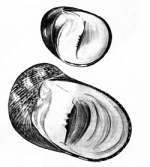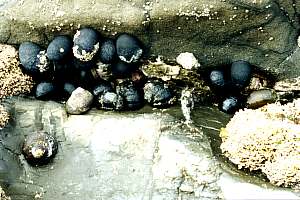 (Morton & Miller, 1968) |
 |
Description: The family is typically a tropical group. A related
species in the West-Indies is the well known 'Bleeding Tooth'.
There is something fascinating about the black dull surface when wet
or dry, and the contrast with the curiously porcelain pellucid blue-white
inner surface. The columella lip inside the opening extends inwards and
part of the way across the opening as a white partition, reducing the size
and shape of the mouth opening to a half-circle. The operculum is rather
beautiful: granulated and marked in orange and mauve, semi-circular in
shape, with a curious process on its inner surface.
Habitat: In the Hauraki Gulf, Nerita ranges from the littoral fringe down to the bottom of the barnacle zone, and in the far north, where it reaches its maximum, it extends plentifully to low tide.
Biology: Like the periwinkles, Nerita can when necessary
breathe in damp air, and it lives by scraping up algae and organic debris
with its strong, broad radula. The eggs are deposited under stones in high
tidal pools, clustered in tough capsules, forming small greyish-white patches.
Its main predators are the white (Dicathais orbita) and dark
(Haustrum
haustorium) rock shells, which rarely leave the water of nearby rockpools.
Nerita is essentially a 'crash helmet' with a low profile and a wide
foot, offering secure attachment. This shape offers least resistance to
waves and moving debris like sand and rocks. When suddenly prized from
the rock, and turned, it draws its operculum close, releasing a large droplet
of water, its 'survival package' against drying out. Its gills, while wetted
by water, are capable of breathing air, thus enabling it to live high up
the shore, out of reach of its predators. Neritas are often found huddling
together in moist recesses, usually facing away from the sun. In this manner
they can withstand large waves, while being close enough to exchange spawn.
This behaviour also traps more moisture in between them.
Distribution: Nerita is a warm water snail, common on Australian
coasts from Queensland to Perth, and at the Kermadec and Norfolk Islands.
Even at Auckland, its range is far more limited than in Northland, and
it is there almost absent from harbours. It is found at Taranaki and Hokianga,
but is elsewhere almost lacking on the west coast. South of East cape it
is a rare shell, and at Cook Strait is hard to find even one.
 (Morton & Miller, 1968) |
 |